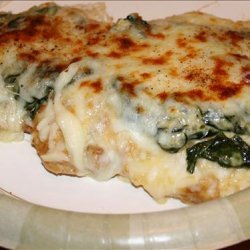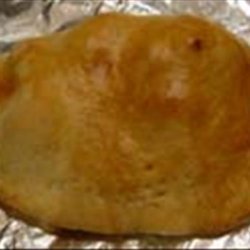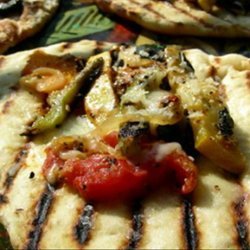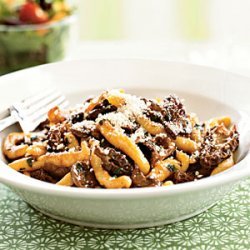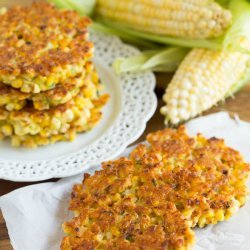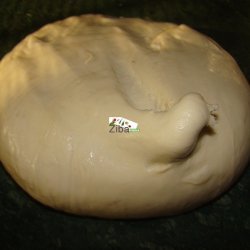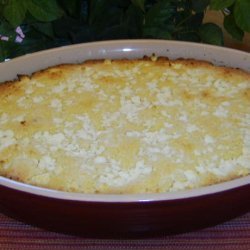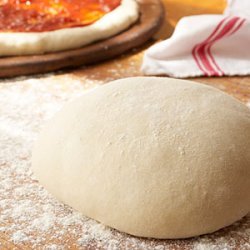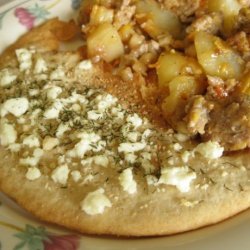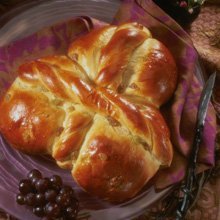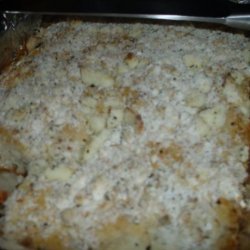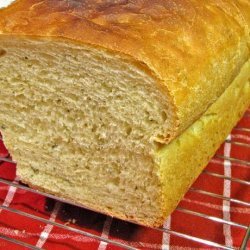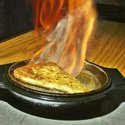Directions:
- Lightly oil a large bowl and set it aside. Mix the flour and salt together in a second large bowl. Make a well in the middle and slowly blend in the warm water, using an electric mixer or a fork, until a stiff dough has formed.
- Lightly sprinkle a work surface with flour, and transfer the dough to it. Knead and fold the dough until it is elastic and shiny, about 10 minutes. Pat the dough into a ball, place it in the oiled bowl, and turn to coat it all over with the oil. Cover with a cloth or plastic wrap and set aside in a warm place to rest for 2 hours.
- Dust the work surface again with a light layer of flour. Divide the dough into four pieces. With a 1 1/2 inch diameter dowel, roll each piece out to form a 10 inch circle. Lay the dough circles out on a dry surface that has been dusted with cornstarch, cover them with a cloth, and allow to rest for 30 minutes.
- Dust the rolling surface again. With the dowel, roll each circle as thin as you can. This dough is very elastic, and you will probably have to use your hands to stretch it as well as roll it. You can roll the whole circle of dough around the rolling stick, and holding up the stick let the dough slowly unroll so that gravity helps stretch it. After rolling and stretching each circle as thin as you can, place a clean, smooth cloth over your table. Dust the cloth with flour and lay the rolled pastry in the center. With both hands, stretch the dough until it is as thin as a dime and at least 14 x 12 inches in size. Don’t worry about any holes; you can work around them later.
- When the dough is stretched thin, cut sheets the size you desire. Save any trimmings to roll again. Continue with the other circles until all the filo is rolled and cut. Keep the rolled sheets covered until ready to use.
- Use the filo sheets right away, or sprinkle them with flour and stack them one on top of another. Loosely roll the stack up into a log. Wrap in plastic wrap and refrigerate for up to 2 weeks, or freeze for up to 6 months. Makes 4 to 6 sheets: enough for a 12 x 9 inch pan.
- VARIATIONS:.
- FILO WITH CARBONATED WATER, BEER, OR BAKING POWDER: Some Greeks substitute carbonated water or beer for the plain water, or add a little baking powder, to get a bit of rise in their dough.
- When using carbonated water or beer, simply replace the water with the liquid of choice.
- When adding baking powder, include 2 teaspoons baking powder when you mix together the flour and salt in Step 1. Include 2 Tablespoons olive oil along with the first 1/2 cup water; then add up to 1/4 cup more water, as needed, to form a stiff dough.
- FILO WITH VINEGAR OR LEMON JUICE: Vinegar and lemon juice, in some opinions, add a little sparkle and elasticity to the dough. Vinegar in the dough goes particularly well with pitas filled with spinach, leeks, or various greens.
- To use, include 1 tablespoon white wine vinegar or lemon juice and 2 tablespoons olive oil along with the first 1/2 cup water. Add up to 1/4 cup more water, as needed.
- FILO WITH EGG, MILK, OR YOGURT: Occasionally a dough maker will enrich filo dough with an egg, or will use milk or yogurt instead of the water. The resulting dough is yellower and creamier.
- When adding egg, you will need to use a little less water or a little more flour to achieve a stiff dough. It takes approximately 4 cups of flour to make the dough stiff enough when using 2 eggs.
- To use milk, simply substitute the same amount of milk for the water.
- When replacing water with yogurt, use either less flour or add a few extra tablespoons of water to achieve a stiff dough.
- FILO WITH OIL: Many Greeks use oil in their filo dough. Oil makes the dough even more elastic, though a bit less flaky. Use 3/4 cup warm water, 1/3 cup oil and 1/2 cup more flour. The oil can be olive oil, a flavorful nut oil, or for a very Mediterranean touch, sesame oil. You can also use part oil and part melted butter. Work the dough as little as possible; stop when it holds together.
- Adventures In Greek Cooking The Olive And The Caper.
Nutrition Facts
| Amount Per 1 Serving | |||
| Calories | 341.25 Kcal (1429 kJ) | ||
| Calories from fat | 8.44 Kcal | ||
| % Daily Value* | |||
| Total Fat | 0.94g | 1% | |
|---|---|---|---|
| Sodium | 583.99mg | 24% | |
| Potassium | 100.43mg | 2% | |
| Total Carbs | 71.25g | 24% | |
| Dietary Fiber | 2.81g | 11% | |
| Protein | 9.38g | 19% | |
| Iron | 0.9mg | 5% | |
| Calcium | 18.2mg | 2% | |
| Amount Per 100 g | |||
| Calories | 257.4 Kcal (1078 kJ) | ||
| Calories from fat | 6.36 Kcal | ||
| % Daily Value* | |||
| Total Fat | 0.71g | 1% | |
|---|---|---|---|
| Sodium | 440.49mg | 24% | |
| Potassium | 75.75mg | 2% | |
| Total Carbs | 53.74g | 24% | |
| Dietary Fiber | 2.12g | 11% | |
| Protein | 7.07g | 19% | |
| Iron | 0.7mg | 5% | |
| Calcium | 13.7mg | 2% | |
* Percent Daily Values are based on a 2000 calorie diet. Your daily values may be higher or lower depending on your calorie needs.
Find out how many calories should you eat.
Get Your Recipe of Health!
Follow RecipeOfHealth on Facebook!


